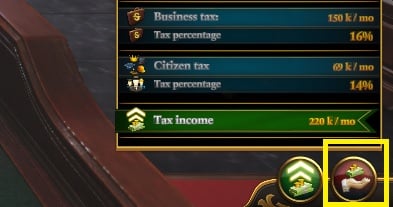City Council | Politics
In the chapter below, you will find a wide range of essential information about the City Council and the voting system, which is the mechanism behind enforcing individual decisions. The information in this chapter will allow you to avoid making many mistakes during the campaign, and will also allow you to effectively lead the political game and stay in power.
General information
Just after the first several minutes in the campaign, you will notice, that every decision, which has any impact on the fate of the city, has to be discussed and voted upon by the City Council. The number of debates is dependant only on your activities and individual projects, but even if you do not introduce many projects, the game will force it upon you by using various political parties, that can support a given initiative.
The City Council in Urban Empire consists of 61 members, who represent various political parties. In the beginning stages of the campaign, there will be only a few parties, which will allow you to get accustomed with the mechanics of the game, but from Era II, the parties you got to know earlier will split into smaller groups, concentrated around a value that they find particularly important. This is very essential, as you always have to observe the shifting political landscape and react according to the current balance of power, enforcing political decisions which favour the party with the most representatives.
City Council view
Before we move on to further issues, it is worth explaining the individual elements of the panel, which serves as a tool of communication with the City Council.

The picture above shows the City Council panel right after it is opened by using a keyboard shortcut or clicking the appropriate icon from the City view. It is simultaneously the City Council view, which gives you precise information about the parties and about the representatives of each of the parties[5]. Under the list you can also see the balance of the city funds [6].
1. Party details
Each position from the list of parties visible in the picture can be clicked, and upon doing so a second panel will pop up, and allow you to familiarize yourself with the ideology of each party. Here you can check citizen support for a given party, which even takes into consideration specific social groups. Apart from that, you will also find the characteristics of each party, their main goal connected to services, and a list of edicts proposed by the party together with the information about whether or not they were introduced. You can also find the relations between certain parties here.
![The arrow visible on the screen allows you to switch between parties [1], the amplifying glass [2] appears in the second Era, when you get the opportunity to spy on parties, and the political compass [3] indicates the ideology of the group - City Council | Politics - Politics - Urban Empire Game Guide](/urban-empire/gfx/word/519642075.jpg)
The arrow visible on the screen allows you to switch between parties [1], the amplifying glass [2] appears in the second Era, when you get the opportunity to spy on parties, and the political compass [3] indicates the ideology of the group.
2. Edicts
By using the two icons placed in the bottom right corner of the screen, you can switch between the active edicts (the green colour), and the edicts that can be submitted to a vote (the red colour). At the beginning it will be easier to use the All categories filter, thanks to which none of the available notions will escape your attention, but given time the amount of edicts will be too great, and it will be better to browse through them by using specific categories.
3. Taxes

Another function of the panel in question, is connected to taxes. After selecting the indicated icon, you will see a panel which shows the inflows to the budget, that come from the taxed paid by people and enterprises. You can also see the percentage level of taxes here. After choosing the icon in the bottom right corner you will be able to change the percentage values of taxes for specific social groups. When the values change, a motion with new tax values will be put forward to the City Council and will have to be approved.
4. Funding services
The final function of the City Council view is connected to funding various services. By using the panel you can familiarize yourself with the current spending of the city funds. They are primarily connected with remuneration for the mayor, but also with the funding of various institutions, which operate within the borders of each district. Depending on the income of the city, you can establish the level of aid for every institution, by using the green icon in the bottom right corner of the screen.
You are not permitted to copy any image, text or info from this page. This site is not associated with and/or endorsed by the Kalypso Media or Fragment Production. All logos and images are copyrighted by their respective owners.
Copyright © 2000 - 2025 Webedia Polska SA for gamepressure.com, unofficial game guides, walkthroughs, secrets, game tips, maps & strategies for top games.
